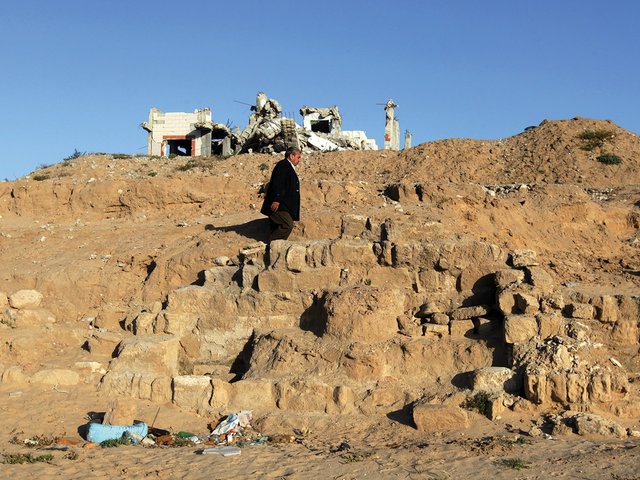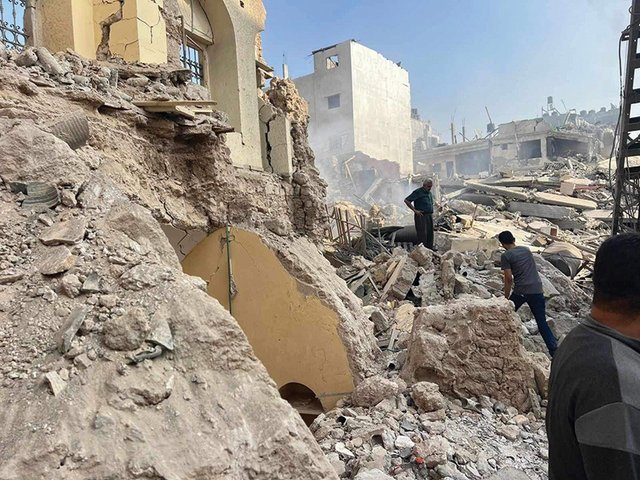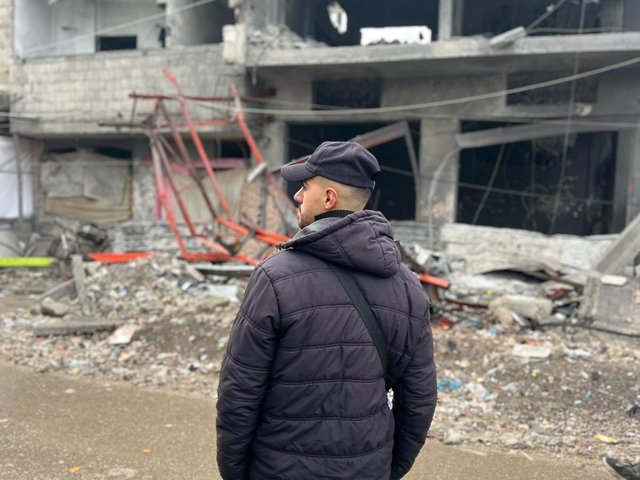Jerusalem
After a 3,500-year history of invasions, the latest war on the beleaguered coastal strip of Gaza has once again put historic sites at risk.
The fragile ceasefire in force as The Art Newspaper went to press (21 January) has allowed some information to emerge about the fate of Gaza’s cultural heritage. Gaza’s only museum, a private antiquities museum run by Gazan contractor and collector Jawdat Khoudary, was badly damaged during Israel’s 22 days of air and land strikes. The glass doors and windows have been shattered and the roof and walls have been damaged. Roman and Byzantine pottery, Islamic bronze objects and many amphorae have been destroyed, initially during shooting 20m to 200m away, and later because of nearby shelling, with one direct hit to the museum’s conference hall, Mr Khoudary said. Amphorae, clay and ceramic vessels with two looped handles, were created in Gaza and the region during the fourth to seventh centuries for holding wine, olive oil and food and trading perishable commodities.
Meanwhile, anxieties are growing about the fate of the city’s antiquities. “I am very concerned: the entire Gaza Strip is an archaeological site,” Palestinian archaeologist Professor Moain Sadeq said.
Professor Sadeq founded the Palestinian Antiquities Department of Gaza in 1994, and is currently a visiting lecturer at the University of Toronto while in contact daily with Gaza. “Historical sites and buildings in Gaza are adjacent to urban areas, so any location that was hit as a target also put the nearby historical sites and buildings in danger,” he said. Major sites where damage is expected because of heavy fighting in adjacent areas include: Tell as-Sakan, an early Bronze Age settlement which is the largest and oldest walled Canaanite city in the local region, and the oldest Egyptian fortified site outside of Egypt; Tel el-Ajull, an important middle and late Bronze period city that was an important trade hub between ancient Egypt and the Levant; and the remains of Anthedon, a Hellenist port. The Byzantine church of Jabalya was also near heavy fighting, and was the site of partial damage by Israeli tanks during an incursion in 2005. Al-Zeitoun residential quarter in Gaza’s Old City, a medieval historic district, has also been largely destroyed, Professor Sadeq added.
Archaeologists are expecting assessment of all of Gaza’s historical sites to be slow. As humanitarian assistance is the urgent priority, serious archaeological surveys of historic sites will be delayed. “I hope that Israel and the Palestinians will work to restore the sites. I am worried about Gaza sites that were excavated and are above the ground because I am sure during the military activity that some sites have been damaged,” Dr Yigal Yisrael, of the Israel Antiquities Authority Ashkelon region and Western Negev said.
The first mention of an invasion in Gaza dates back approximately 3,500 years to the annals of Pharaoh Tuthmosis III. At least a dozen empires have controlled Gaza, in its 6,000-year known history including the ancient Egyptians, Assyrians, Babylonians, Persians, Macedonians, Romans, Byzantines, Muslims, Crusaders, Mamluks, Ottomans and British, and the modern states of Egypt and Israel. Artefacts from ancient Muslim, Jewish and Christian communities are routinely discovered.
Even so, Gaza has not been widely excavated. In recent history, the Palestinian authorities have faced shortages of funding, staff, equipment and conservation facilities. Local artefacts could previously only be viewed in foreign museums, such as in Istanbul, London and Jerusalem, until Mr Khoudary opened his museum in August with his private collection of artefacts salvaged from land and sea, during two decades in the construction business. The museum was originally planned as a national museum, with backing from Palestinian Authority President Mahmoud Abbas, until Hamas took authority in Gaza in 2007.
Since 1994, seven major sites in Gaza have been excavated by the Palestinian Antiquities Authority, but in late 2000 activity stalled with the rise of the intifada. According to American archaeologist Professor Lynn Swartz Dodd of the University of Southern California, the latest war in Gaza has also stalled plans for joint Israeli-Palestinian excavation projects in the West Bank, including a heritage preservation field school.
Professor Dodd and Professor Ran Boytner of the University of California, Los Angeles, oversaw a five-year secret committee of Israeli and Palestinian archaeologists that culminated last year in the publication of a 39-point archaeological joint heritage plan, dubbed “the archaeological peace plan”. This group also published the first public archaeological database of archaeological work in the West Bank and Gaza since 1967.
“A significant educational and training endeavour and the intended investment in a heritage resource that would have been made through that partnership have become invisible causalities of [the] conflict,” Professor Dodd told The Art Newspaper.
Professor Sadeq says that the need now is to invite colleagues from abroad to come and help in Gaza. New sites may also emerge from such an effort, as scores of buildings were erected without salvage excavations first, before he founded the Gaza Antiquities Department in 1994, he adds.
“We need expertise, technical support and various types of help with conservation,” Professor Sadeq said. Swiss experts from Geneva’s Museum of Art and History, which hosted the first satellite show of Gaza antiquities in 2007 from Mr Khoudary’s collection, have already voiced plans to assist with assessment and conservation. “I hope other international organisations will also help. If there is peace, antiquities should be a priority, after humanitarian aid,” Mr Khoudary said.




